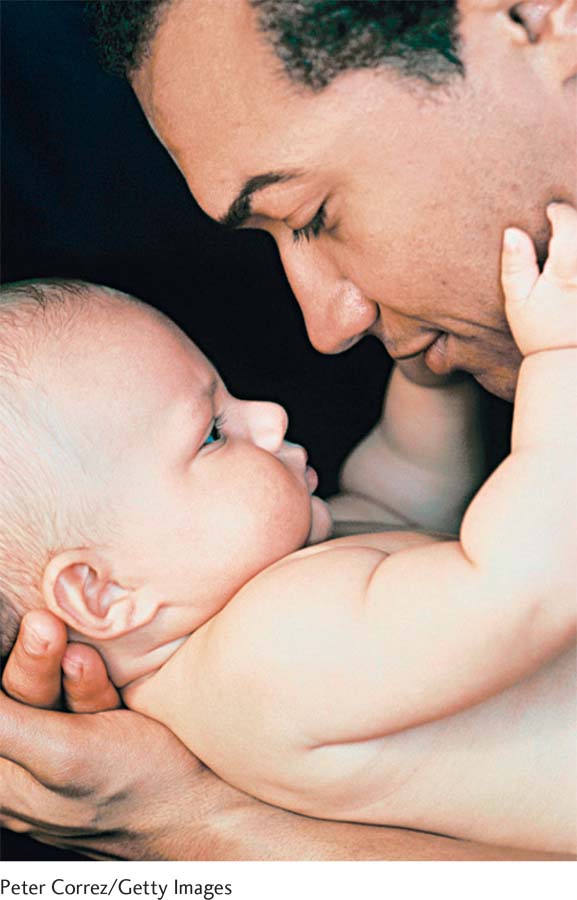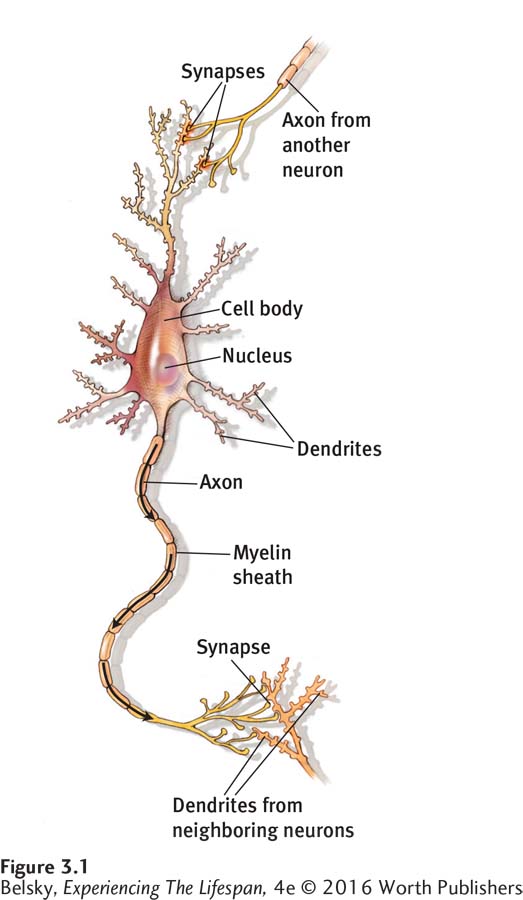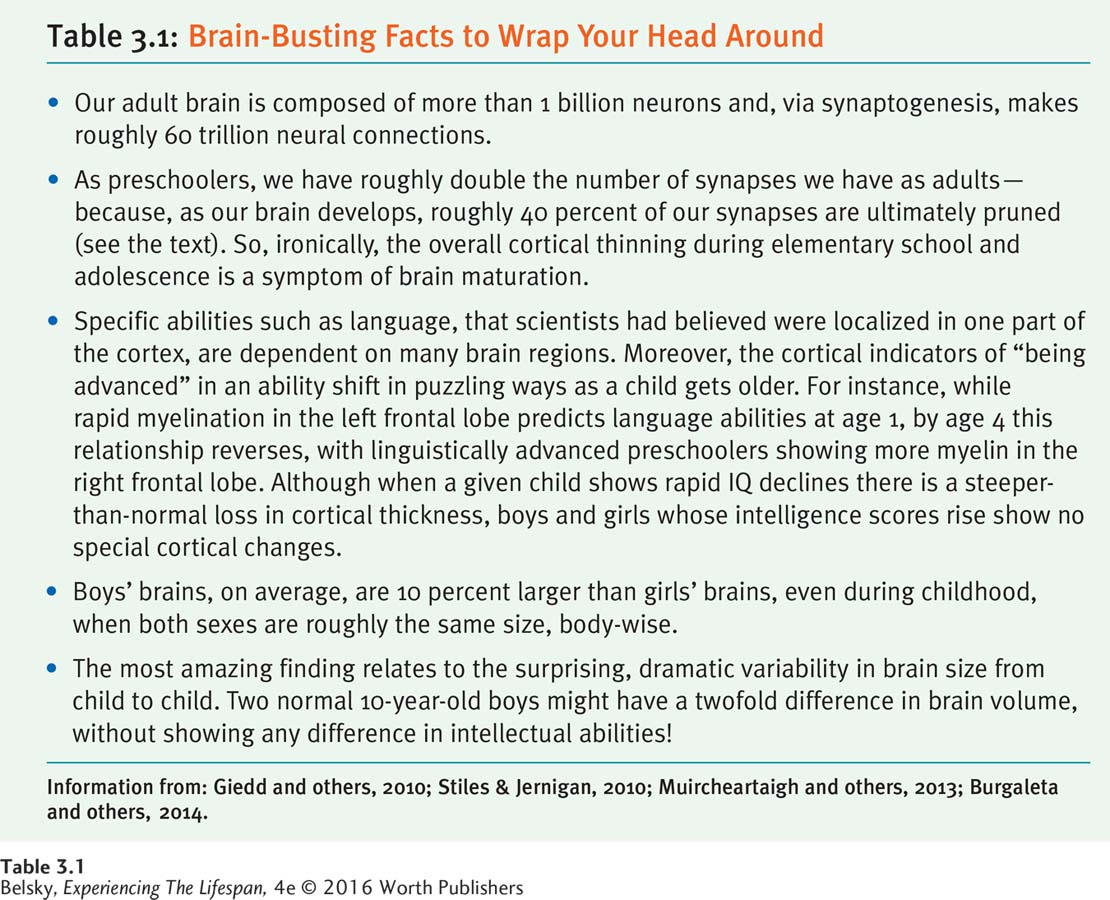3.1 Setting the Context
74
What causes the remarkable changes—

The Expanding Brain

The cerebral cortex, the outer, furrowed mantle of the brain, is the site of every conscious perception, action, and thought. With a surface area 10 times larger than the monkey’s and 1,000 times larger than the rat’s, our cortex is what makes human beings different from any other species on earth.
Because of our immense cortex, humans are also unique in the amount of brain growth that occurs outside of our womb. During the first four years of life, brain volume quadruples (Stiles & Jernigan, 2010). It takes more than two decades for the brain to fully mature. Actually, the cortex only starts taking over our behavior a few months after birth.
Recall from Chapter 2 that by the middle of the fetal period the cells that compose the brain have migrated to the top of the neural tube. During the final months of pregnancy, and the first year of life, they differentiate into their mature form. The cells form long axons—fibers that conduct impulses away from the cell body. They sprout dendrites—treelike, branching ends. As the dendrites proliferate at junctions, or synapses, the axons and dendrites interconnect (see Figure 3.1).
Synaptogenesis, the process of making myriad connections, programs every skill—
Synaptogenesis and myelination occur at different rates in specific brain regions (Dean and others, 2014). In the visual cortex, the part of the brain responsible for interpreting visual stimuli, the axons are myelinated by about age 1. In the frontal lobes, the brain region involved in reasoning, the myelin sheath is still forming into our twenties.
This makes sense. Seeing is a skill we need soon after birth. Visual abilities, as you will learn in this chapter, develop rapidly during our first year of life. But we won’t need the skills to compose symphonies, do higher math, or competently make our way in the world until we become adults. So there are parallels between our unfolding abilities and the way our brain matures.
Neural Pruning and Brain Plasticity
So far, you might imagine that more neural connections equal superior skills. Not so! Neural loss is critical to development, too. Following a phase of lavishly producing synapses, each cortical region undergoes synaptic pruning and neural death. This shedding timetable also reflects our expanding abilities. It begins around age 1 in the visual cortex. It starts during late childhood in the frontal lobes. Just as weeding is critical to sculpting a beautiful garden, we need to get rid of the unnecessary neurons to permit the essential cells to flower.
Why does the brain undergo this frantic overproduction, followed by cutting back? Clues come from research suggesting that during infancy, synaptic connections progressively strengthen in more distant areas of the brain (Damaraju and others, 2014). Perhaps, having an oversupply of connections allows us to “recruit” from this wider pool and redirect these extra neurons to perform other functions, should we have a major sensory deficit or brain insult early in life (Fox, Levitt, & Nelson, 2010; Stiles & Jernigan, 2010). Actually, our cortex is malleable or plastic (able to be changed), particularly during infancy and the childhood years.
75
Using the fMRI, which measures the brain’s energy consumption, researchers find that among people blind from birth, activity in the visual cortex is intense while reading Braille and localizing sounds in space. This suggests that, without environmental stimulation from the eye, the neurons programmed for vision are captured, or taken over, to strengthen hearing and touch (Collignon and others, 2011; Fox, Levitt, & Nelson, 2010).
A similar process occurs with language, normally represented in the left hemisphere of the brain. If an infant has a left-
So, brain plasticity highlights the basic nature-
Table 3.1 on page 76 offers additional fascinating facts about neurons, synaptogenesis, and the pruning phase. Notice from the last item that, in the same way as the houses in your subdivision look different—

76

Now keeping in mind the basic brain principles—
Tying It All Together
Question 3.1
Cortez and Ashley are arguing about what makes our brain unique. Cortez says it’s the immense size of our cortex. Ashley says it’s the fact that we “grow” most of our brain after birth and that the cortex continues to mature for at least two decades. Who is right—
Both Cortez and Ashley are right. We are unique in our massive cerebral cortex, in growing most of our brain outside of the womb, and in the fact that the human cortex does not reach its adult form for more than two decades.
Question 3.2
Latisha tells you that the myelin sheath speeds neural impulses and the more synaptic connections, the higher the level of development. Is Latisha totally correct? If not, describe how she is wrong?
Latisha is only partly right. Synaptic loss and neural pruning are essential to fostering our emerging abilities.
Question 3.3
When babies have a stroke, they may end up (choose one) more/less impaired than they would be as adults, due to a phenomenon called brain (choose one) myelination/plasticity.
When babies have a stroke, they may end up less impaired than during adulthood, due to brain plasticity.
Question 3.4
Which neural process is occurring right now in your mom and your elderly grandma? (Choose one) myelination/synaptogenesis
Synaptogenesis is occurring in your mom and grandma. Myelination (or formation of the myelin sheath) ends by our mid-